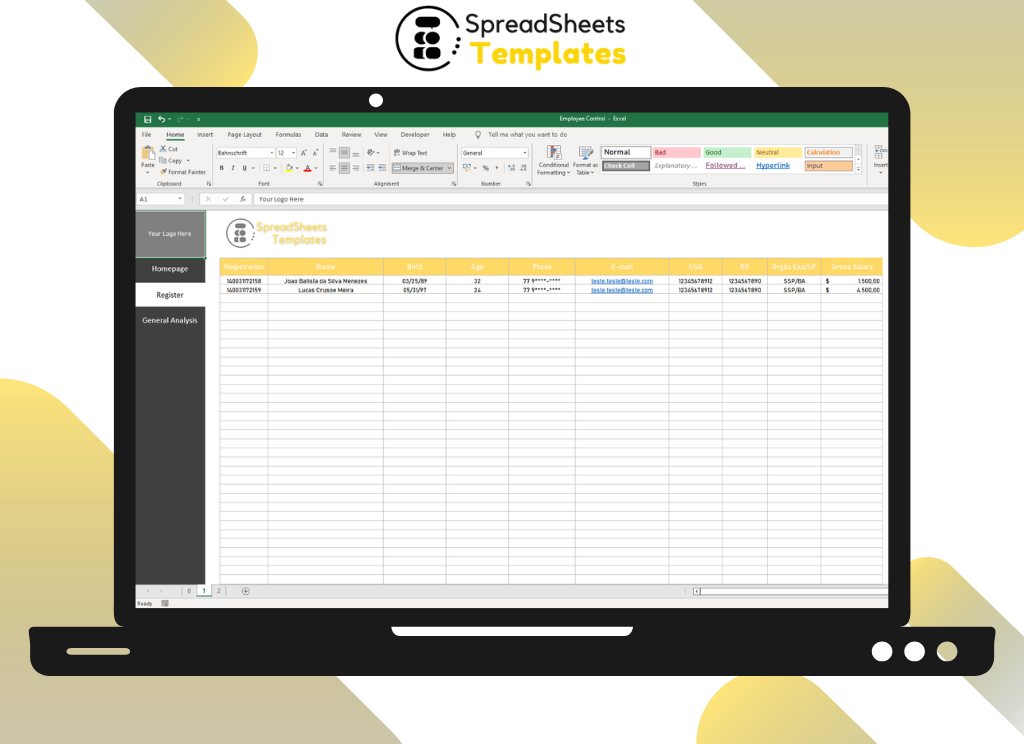Employee Control Worksheet Leave a comment
Managing and Maximizing Workforce Efficiency
Introduction
In today’s fast-paced and competitive business landscape, effectively managing employees and optimizing their productivity is paramount to success. One valuable tool that aids in this process is the Employee Control Worksheet. This comprehensive guide will delve into the intricacies of the Employee Control Worksheet, its benefits, and how it can help businesses achieve greater efficiency and performance. So, let’s dive in and explore this powerful resource that can revolutionize the way organizations manage their workforce.
What is an Employee Control Worksheet?
An Employee Control Worksheet is a systematic document that assists businesses in managing and controlling employee activities, tasks, and performance. It serves as a centralized hub for monitoring and evaluating employees, tracking their progress, and ensuring that organizational goals are met. By providing a structured framework for assessing employee performance and productivity, the Employee Control Worksheet empowers managers to make informed decisions and take necessary actions to optimize workforce efficiency.
Employee Control Worksheet: How It Works
The Employee Control Worksheet operates on a simple yet effective principle: it allows managers to track and evaluate various aspects of employee performance. It typically includes the following sections:
1. Employee Information
In this section, pertinent details about each employee are recorded, such as their name, designation, department, and contact information. This ensures that all employee information is easily accessible for quick reference.
2. Task Assignments
Here, managers assign specific tasks and responsibilities to employees. This helps in creating clarity regarding individual roles and streamlining the workflow within the organization.
3. Progress Tracking
In this section, managers can monitor the progress of each assigned task. It allows them to identify potential bottlenecks, provide timely feedback, and make necessary adjustments to ensure tasks are completed efficiently and on time.
4. Performance Evaluation
The performance evaluation component of the Employee Control Worksheet enables managers to assess employee performance against predefined benchmarks and criteria. It provides a holistic view of each employee’s strengths, weaknesses, and areas for improvement.
5. Attendance and Punctuality
Tracking attendance and punctuality is crucial for maintaining discipline and ensuring employees adhere to their work schedules. The Employee Control Worksheet allows managers to record and monitor employee attendance to identify patterns and address any concerns promptly.
6. Training and Development
Employee growth and development are essential for both personal and organizational success. With the Employee Control Worksheet, managers can identify skill gaps and allocate resources for training and development initiatives, ensuring continuous improvement within the workforce.
7. Feedback and Communication
Effective communication and feedback are vital for fostering a positive work environment. The Employee Control Worksheet facilitates regular feedback sessions and communication channels between managers and employees, promoting open dialogue and mutual understanding.
Benefits of Using an Employee Control Worksheet
Implementing an Employee Control Worksheet can yield numerous advantages for businesses. Here are some key benefits:
- Enhanced Workforce Efficiency: By systematically tracking employee tasks and performance, the Employee Control Worksheet helps identify areas of improvement and maximize workforce efficiency.
- Goal Alignment: The Employee Control Worksheet allows managers to align individual goals with organizational objectives, ensuring that every employee’s efforts contribute to overall success.
- Performance Evaluation: With the Employee Control Worksheet, managers can objectively evaluate employee performance, recognize high achievers, and provide targeted support to those who require assistance.
- Resource Allocation: The ability to identify skill gaps through the Employee Control Worksheet enables businesses to allocate resources for training and development, fostering a skilled and capable workforce.
- Improved Communication: The Employee Control Worksheet facilitates regular feedback sessions and communication channels, promoting transparency, collaboration, and employee engagement.
- Time Management: By monitoring progress and task completion, the Employee Control Worksheet helps managers identify time-consuming activities and optimize work processes, leading to better time management across the organization.
Frequently Asked Questions (FAQs)
Q1: How can an Employee Control Worksheet benefit small businesses?
An Employee Control Worksheet is equally valuable for small businesses. It enables effective workforce management, helps identify areas for improvement, and ensures that limited resources are utilized optimally.
A1: The Employee Control Worksheet assists small businesses in streamlining operations, tracking employee performance, and fostering growth by aligning individual efforts with organizational goals.
Q2: Can the Employee Control Worksheet be customized to fit specific business needs?
Absolutely! The Employee Control Worksheet is a flexible tool that can be tailored to meet the unique requirements of any business. Customization options include task categories, performance metrics, and reporting formats.
A2: Businesses can customize the Employee Control Worksheet to align with their specific goals, metrics, and performance evaluation criteria, making it a versatile tool suitable for any organization.
Q3: Is it possible to integrate the Employee Control Worksheet with existing HR software?
Yes, many HR software platforms allow integration with the Employee Control Worksheet. This seamless integration enhances data management capabilities, streamlines workflows, and provides a comprehensive view of employee performance.
A3: Integrating the Employee Control Worksheet with HR software ensures a centralized data repository, reduces manual effort, and enables seamless collaboration between different departments.
Q4: How often should the Employee Control Worksheet be updated?
The frequency of updates depends on the organization’s needs and the nature of the tasks involved. It is generally recommended to update the Employee Control Worksheet regularly, incorporating changes, new assignments, and performance evaluations.
A4: Regular updates to the Employee Control Worksheet ensure accurate and up-to-date information, enabling managers to make informed decisions and take timely actions to optimize workforce efficiency.
Q5: Can the Employee Control Worksheet be accessed remotely?
Yes, with the advancement of technology, the Employee Control Worksheet can be accessed remotely through cloud-based platforms or dedicated software applications. This allows managers and employees to collaborate effectively, regardless of their physical location.
A5: Remote access to the Employee Control Worksheet facilitates flexible work arrangements, enhances productivity, and supports a geographically distributed workforce.
Q6: Are there any specific employee privacy concerns associated with using an Employee Control Worksheet?
When implementing an Employee Control Worksheet, it is crucial to adhere to data privacy regulations and ensure that employee information is handled securely. Proper access controls and data protection measures should be in place to safeguard sensitive data.
A6: Organizations should prioritize data privacy and implement robust security measures to protect employee information while utilizing the benefits offered by the Employee Control Worksheet.
Conclusion
Efficiently managing and maximizing workforce efficiency is a top priority for businesses aiming to thrive in today’s competitive landscape. The Employee Control Worksheet empowers organizations to streamline operations, track performance, and align individual efforts with overall goals. By utilizing this comprehensive tool, businesses can optimize their workforce, drive productivity, and achieve sustainable success.
Implementing an Employee Control Worksheet is a strategic investment that yields significant returns in terms of improved efficiency, enhanced communication, and employee development. So, take control of your workforce and unlock their true potential with the power of the Employee Control Worksheet.


